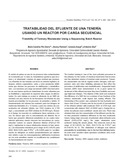| dc.rights.license | http://creativecommons.org/licenses/by-nc-sa/3.0/ve/ | |
| dc.contributor.author | Pire Sierra, María Carolina | |
| dc.contributor.author | Palmero, Jhonny | |
| dc.contributor.author | Araujo, Ismenia | |
| dc.contributor.author | Díaz, Altamira | |
| dc.date.accessioned | 2010-05-27T21:36:57Z | |
| dc.date.available | 2010-05-27T21:36:57Z | |
| dc.date.issued | 2010-06-30 | |
| dc.identifier.issn | 0798-2259 | |
| dc.identifier.uri | http://www.saber.ula.ve/handle/123456789/31109 | |
| dc.description.abstract | El curtido de pieles es uno de los procesos más contaminantes
de la industria por la serie de tratamientos químicos que involucra
y el abundante volumen de agua residual que produce.
Los efluentes de las tenerías son ricos en materia orgánica, nitrógeno,
sólidos suspendidos, sales y otras sustancias inhibidoras
que afectan los procesos de nitrificación y desnitrificación.
Los reactores por carga secuencial (SBR) han demostrado
ser una buena opción de tratamiento de estos efluentes por
su flexibilidad y capacidad de soportar altas cargas de alimentación.
En este trabajo se evaluó la eficiencia de un SBR alimentado
con una mezcla de las fracciones del efluente de una
tenería provenientes de los procesos de pelambre y teñido. El
funcionamiento del sistema fue evaluado para dos tiempos de
residencia hidráulico (8 y 12 horas) y para dos niveles de concentración
del afluente (diluido con DQO máxima de 2.700
mg/L y concentrado con DQO mínima de 25.000 mg/L). Durante
el tiempo de reacción se combinaron fases anóxicas y óxicas.
Se obtuvo que sólo la concentración del afluente fue el
factor que presentó diferencia estadística en los cuatro tratamientos
aplicados, siendo mayores las remociones de contaminantes
cuando se usaron afluentes diluidos (DQO 2.700
mg/L), lográndose la mayor eliminación durante la fase anóxica.
Las remociones estuvieron en el rango de 83,3-85,0% para
DQO; 59,6-73,0% para P-PO
y 83,9-84% para Cr. La eliminación
de nitrógeno se realizó presumiblemente por asimilación
debido a que los microorganismos nitrificantes mostraron
ser los más sensibles cuando se modificaron las condiciones
de funcionamiento del reactor. | es_VE |
| dc.language.iso | es | es_VE |
| dc.publisher | SABER ULA | es_VE |
| dc.rights | info:eu-repo/semantics/openAccess | |
| dc.subject | Tenería | es_VE |
| dc.subject | SBR | es_VE |
| dc.subject | Materia orgánica | es_VE |
| dc.subject | Nutrientes | es_VE |
| dc.title | Tratabilidad del efluente de una tenería usando un reactor por carga secuencial | es_VE |
| dc.title.alternative | Tratability of tannery wastewater using a sequencing batch reactor | es_VE |
| dc.type | info:eu-repo/semantics/article | |
| dc.description.abstract1 | The leather tanning is one of the most pollutant processes in
the industry for the series of chemical treatments that involves
and the abundant volume of residual water produced. Tanneries
wastewaters are rich in organic matter, nitrogen, solid suspended,
salts and other inhibiting substances that affect the
processes of nitrificación and desnitrificación. Sequential batch
reactors (SBR) have demonstrated to be a good option for
treatment of this effluent because they have flexibility and manage
high load charges. The objetive of this work was evaluated
the efficiency of a SBR fed on a mixture of two fractions of the
tannery wastewater, soak liquour and dyeing effluent. The
functioning of the system was evaluated for two hydraulic residence
time (8 and 12 hours) and for two levels of concentration
of the influent (diluted with maximum DQO of 2700 mg/L and
concentrate with minimal DQO of 25000 mg/L). During the reaction
two phases were combined: anoxic and oxic. There was
obtained that only the concentration of the influent was the factor
that presented statistical difference in the four treatments
tested, being major removals of pollutants when influents were
diluted (DQO 2700 mg/L), the major elimination were
achieved during the anoxic phase. The removals were in the
range of 83.3-85.0% for DQO; 59.6-73.0% for P-PO
and
83.9-84.0% for Cr. The elimination of nitrogen was achived
presumably by assimilation, due to the fact that nitrifying bacteria
were more sensitive when operation conditions were modified
in the reactor. | es_VE |
| dc.description.colacion | 284-292 | es_VE |
| dc.description.email | carol_pire@yahoo.es. | es_VE |
| dc.description.email | adiaz2430@hotmail.com | es_VE |
| dc.description.frecuencia | Bimestral | |
| dc.identifier.depositolegal | 199102ZU46 | |
| dc.publisher.pais | Venezuela | es_VE |
| dc.subject.institucion | Universidad del Zulia (LUZ) | es_VE |
| dc.subject.institucion | Universidad de Los Andes (ULA) | es_VE |
| dc.subject.keywords | Tannery | es_VE |
| dc.subject.keywords | SBR | es_VE |
| dc.subject.keywords | Organic matter | es_VE |
| dc.subject.keywords | Nutrients | es_VE |
| dc.subject.publicacionelectronica | Revista Científica | |
| dc.subject.seccion | Revista Científica: Producción Animal | es_VE |
| dc.subject.thematiccategory | Medio Ambiente | es_VE |
| dc.subject.tipo | Revistas | es_VE |
| dc.type.media | Texto | es_VE |


